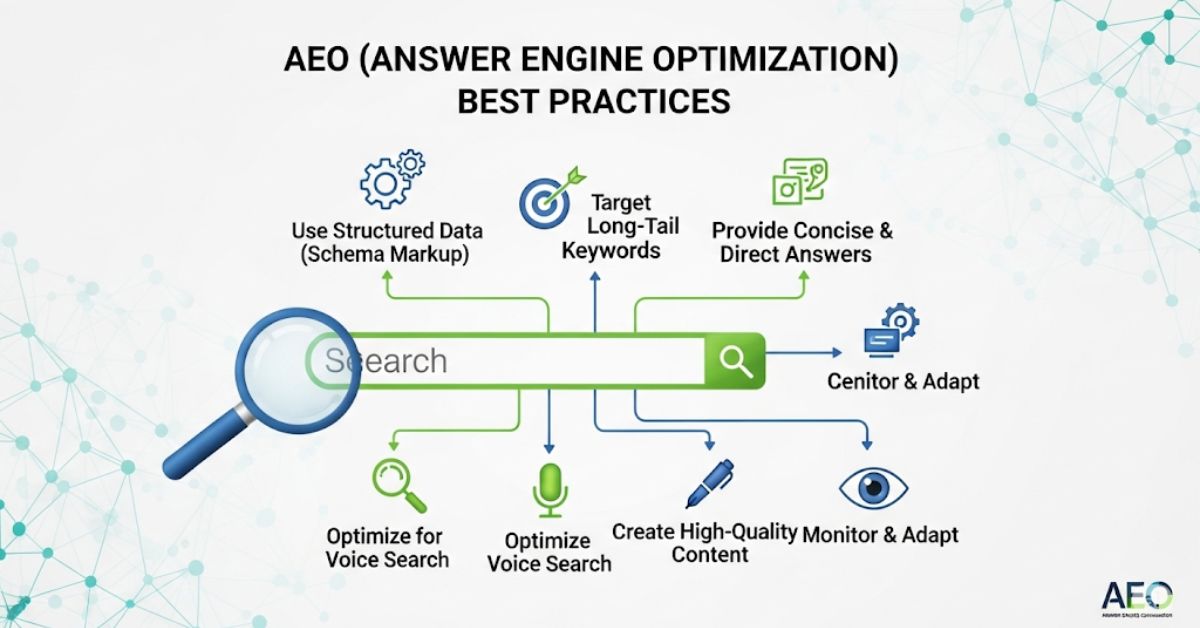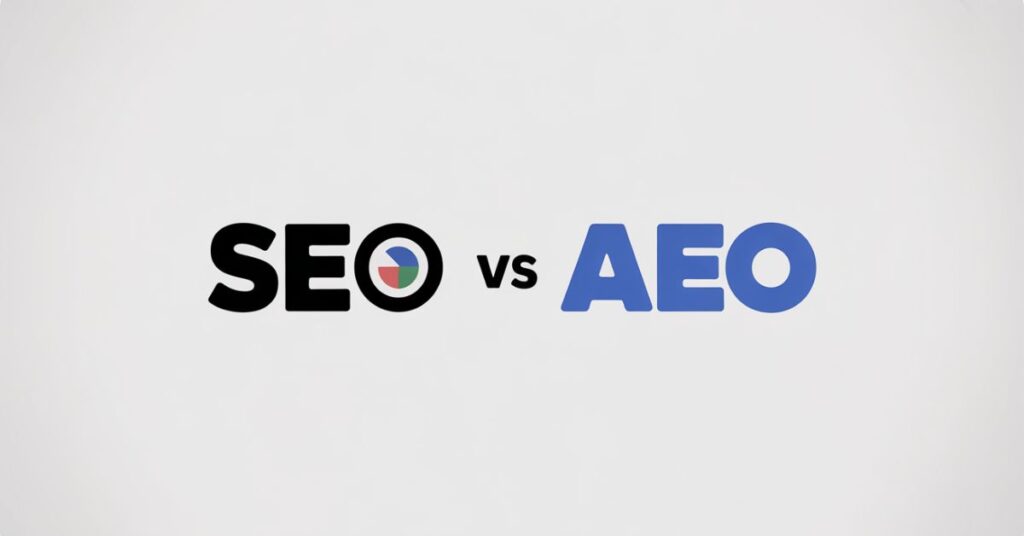Search behavior has evolved rapidly over the past few years. Users no longer want to scroll through multiple links or visit several websites to find answers. Instead, they prefer quick, accurate, and reliable responses delivered directly by AI tools and voice assistants. This transformation is being driven by answer engines like Google’s Search Generative Experience (SGE), ChatGPT, Bing Copilot, and others.
Answer Engine Optimization (AEO) focuses on making your content the preferred source of these AI-generated responses. By optimizing for AEO, you’re not just aiming to rank in search results, you’re aiming to be the answer.
AEO is essential in 2025 because:
- Voice search usage continues to increase.
- AI chatbots are replacing traditional search behaviors.
- Zero-click searches are on the rise.
Adopting AEO ensures your content is not only found but trusted and featured prominently.
Why AEO Matters More Than Ever
AI tools are becoming the first point of contact for information retrieval, whether through voice assistants, smart devices, or AI-powered search experiences. These tools are trained using vast datasets to identify and extract content that best addresses user intent in a quick, concise, and factual manner.
In traditional SEO, even content buried deep within a page could still rank well based on keywords and backlinks. But with answer engines, the format and clarity of your content play a much more direct role. AI models prioritize content that is:
- Clearly structured and easy to parse
- Written in a conversational tone
- Directly answering specific user questions
If your content lacks these traits, even if it’s well-written and authoritative, it might be bypassed in favor of content that is easier for machines to interpret.
Additionally, AEO addresses the growing number of zero-click searches, where users get the answer directly from a search result without visiting a website. In this environment, the only content that surfaces is that which AI can efficiently understand and extract from. AEO ensures your content is not only human-friendly but also machine-compatible, bridging the crucial gap between engaging users and satisfying AI algorithms.
AEO vs. SEO: Side-by-Side
| Element | SEO | AEO |
| Focus | Ranking in search engine results | Becoming the featured AI-generated answer |
| Content Style | Keyword-driven | Conversational, intent-based |
| Discovery | Click-through via links | Zero-click answers or citations in AI results |
| Optimization | Technical, backlinks, metadata | Structure, EEAT, direct Q&A formatting |
AEO and SEO work best together. While SEO drives traffic through visibility, AEO enhances credibility and click-worthiness.
Core Principles of AEO
To make your content answer-engine friendly, it must meet the following criteria:
1. Intent-Based, Conversational Content
Searches are no longer typed as keywords, they’re asked as questions: “How do I reset my phone?” or “What is the best time to drink green tea?”
To optimize:
- Identify high-intent queries.
- Create content around real user questions.
- Use a tone that mimics human conversation.
- Format each answer in a concise 40–60 word block.
2. Structured Formatting
Formatting helps machines read your content.
Key techniques:
- Use headings for sections (H1 for title, H2 for subtopics, H3 for supporting points).
- Add bulleted or numbered lists to break down steps.
- Use tables for comparisons.
3. EEAT (Experience, Expertise, Authoritativeness, Trustworthiness)
EEAT is essential for Google’s algorithm and AI engines. It’s how search engines gauge whether your content is credible and safe to cite.
Improve EEAT by:
- Citing reputable sources and studies.
- Using author bios with credentials.
- Publishing first-hand experiences or case studies.
- Ensuring content is up-to-date and accurate.
4. Technical Performance
A great article won’t be seen if your website underperforms.
What to optimize:
- Mobile usability (responsive design)
- Core Web Vitals (LCP, FID, CLS)
- HTTPS for security
- Clean HTML and schema implementation
Best Practice Strategies for AEO
1. Research User Intent Thoroughly
Understanding what people want to know is foundational. Go beyond broad keywords and dig into long-tail, specific questions.
Sources of questions:
- Google’s “People Also Ask”
- Reddit threads and Quora
- Forums related to your niche
- Search bar autocomplete results
2. Implement the Q&A Format Effectively
This format mirrors how AI tools process content.
Best practices:
- Start with a short answer (under 60 words).
- Add in-depth content below.
- Use a question as your subheading.
3. Add Structured Data (Schema Markup)
Schema markup is code that tells search engines what your content is about.
Useful types for AEO:
- FAQPage
- HowTo
- Article
Use schema to highlight which sections are FAQs or how-to steps. Validate markup using Google’s Rich Results Test.
4. Strengthen On-Page SEO Elements
While AEO is about being the answer, basic SEO remains the foundation.
Key elements:
- Compelling meta descriptions (under 160 characters)
- Target keyword in the page title
- Descriptive, clean URLs
- Alt tags for all images
5. Build Authoritative Backlinks
Search engines use backlinks as a sign of trust. The more authoritative your links, the better your chances of being cited by AI.
How to earn backlinks:
- Publish original research or data studies.
- Outreach to bloggers or journalists.
- Guest post on respected sites.
6. Monitor, Measure, and Iterate
Success in AEO requires ongoing evaluation.
Track:
- Featured snippet appearances
- Voice search traffic changes
- Citations in AI tools
Use tools like Google Search Console, Ahrefs, and Semrush to analyze performance.
Pitfalls and Anti-Patterns
Avoid the following mistakes, as they reduce your visibility in answer engines:
- Duplicate Content: Create unique, insightful content.
- Over-Optimization: Don’t stuff content with keywords.
- Ignoring Mobile Usability: Ensure your content is responsive.
- Lack of Expertise: Provide bios, sources, and real value.
- Writing for Bots Only: Write for people first, then optimize.
Real-World AEO Case Studies
Mayo Clinic
Mayo Clinic has emerged as a leading example of successful AEO implementation in the healthcare sector. Their content is meticulously structured with clearly defined sections such as symptoms, causes, treatments, and prevention, making it easy for AI tools to extract relevant answers. Each page includes medical expert authorship and links to related resources. Their use of schema markup, such as MedicalWebPage and FAQPage, signals to search engines that the content is authoritative and answer-ready. As a result, Mayo Clinic frequently appears as a top source in Google SGE, featured snippets, and voice assistant responses.
Bank of America
Bank of America excels in answer engine visibility by providing consumer-friendly financial education content. They format their pages using structured FAQs and step-by-step guides that address common banking queries, such as how to open an account, manage credit, or apply for a loan. The use of HowTo and FAQPage schema enhances machine readability, while consistent updates ensure accuracy. With strong domain authority and a trustworthy reputation, their content is regularly cited in AI-generated responses across financial and banking-related searches.
Amazon
Amazon’s product pages are a prime example of AEO in the eCommerce space. Their content includes detailed product descriptions, structured specifications, customer reviews, and a dedicated Q&A section where users can ask and answer questions. This user-generated content creates a rich database of real-world, natural language queries and answers, which AI engines find extremely valuable. Additionally, Amazon utilizes Product and Review schema to further support indexing. This comprehensive structure allows Amazon to dominate AI-powered search results for a wide range of product-related inquiries.
The Future of AEO
Trends to watch:
- Voice-first search
- Multimodal answers (text + video + audio)
- Predictive AI content delivery
- Transparent citation systems in AI tools
Future-proofing your content requires adapting to new formats and user behaviors.
Conclusion
Answer Engine Optimization is not just a trend, it’s a necessity for thriving in the evolving digital landscape of 2025 and beyond. As AI continues to power search engines and virtual assistants, being the top answer means greater visibility, authority, and user trust. By aligning your content with AEO best practices, you ensure it is easily understood by machines and genuinely helpful to people.
To truly succeed in AEO, start by deeply understanding user intent and crafting responses that are clear, concise, and valuable. Structure your content with readability in mind, apply EEAT principles to build credibility, and earn high-quality backlinks to boost authority. Most importantly, stay agile, monitor performance, adapt to AI trends, and continuously refine your strategy.



